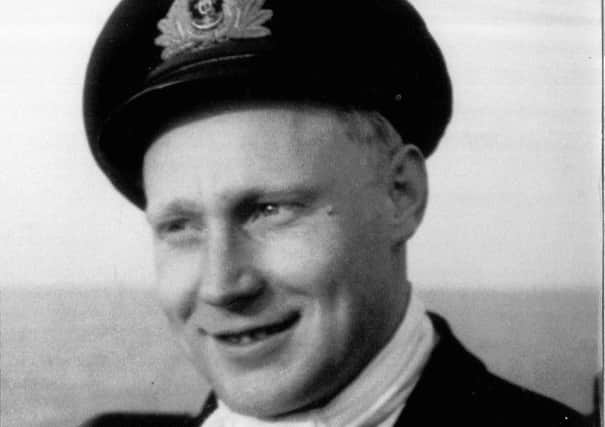Obituary: Alexander Fear, mariner and war hero


Royal Navy Lieutenant Alec Fear’s Edinburgh lass would not marry him until the Second World War was over – a wise caution, considering his engagements with the enemy included the Dieppe Raid of 19 August 1942, in which more than half the 6,000 who took part were killed, wounded, or made prisoner.
In that summer when the Raid took place Lieutenant Fear, aged 23, was the skipper of HM Motor Launch 346, his first command, and the day was to be for him a great victory. In his 112ft craft, he would win a sea-battle against a far larger enemy vessel, driving it aground in flames.Alongside a few British commandos who had got ashore and off the beaches, he managed to silence a mighty German clifftop artillery battery.
Advertisement
Hide AdAdvertisement
Hide AdThrough the terrible events between 4am and 10.30am, Fear fulfilled his orders to land men of the British 3 Commando on the shingle strand known as Yellow Beach One, east of the port town, then stayed for more than two and a half hours inshore, firing constantly with his craft’s armament of a three-pounder, a pair of Oerlikons, and a Lewis gun. The “peashooter armada” of 237 small ships, of which ML346 was one, had been scattered by an unlucky chance encounter with a German armed convoy that happened to cross its path just as it neared Dieppe.The bright burst of star-shell the convoy sent up to illuminate the scene, followed by the flashes and sounds of battle, alerted the defences of the port. This doomed the main mission, an attempt to prove that an enemy port town could be captured and temporarily held. Fear is credited with getting the eastern part of the operation back on form, by rounding up five landing craft and escorting them on their way. Many of those on board would be killed as they tried to get up the beach, but unknown to Fear, as he stayed close by and gave covering fire, 18 other men of the same 3 Commando had already got up on the cliffs, having gone ashore earlier from a sixth landing craft that had made it to another, farther east, stretch of pebbles called Yellow Beach Two.
Looking down from the cliff, where they were approaching the “Goebbels” artillery battery, these commandos watched open-jawed as a 200-ton enemy ship from the convoy, the armed tanker Franz, her red white and black-clad Nazi ensign aloft, bore down on the 85-ton motor launch, in a bid to crush her. At 30 yards, ML 346 kept firing – and in the nick of time, the tanker burst into flames. The enemy crew abandoned ship, and the looming vessel ran aground, leaving Fear victorious. He sent across a boarding party, and captured the ensign, and trophies including the ship’s compass, then turned his guns again inshore, towards the battery.
By 6am, the battery’s guns were out of action. At 6:40am, the British commandos who under cover of ML 346’s fire had reached and disabled them, regained the beach, and, at 8am, in co-ordination with their limping landing craft, Fear from ML 346 fished men holding tow-ropes behind it up and out of the sea and took them home to Newhaven. Fear was awarded the DSC.
Less than two years later both he and the commandos’ leader that day, Major, later Brigadier, Peter Young, would take part in D-Day, 6 June 1944, Young as one of the commando chiefs under Lord Lovat. Fear, still in ML 346, would escort US soldiers to Omaha beach.
In 1945 Fear married Patricia Crawford, always known as Paddy, and they would have three children, Sally, Jacqueline and Angus.
The couple had met when Fear had a few days’ leave in Edinburgh while stationed at Scapa Flow, Orkney. His parents, who lived in Bristol, were friends of her family, and he had promised to visit them.
The sea was part of Fear’s life from childhood: his grandfather had been Harbourmaster of the Port of Bristol, and after his war service and marriage, Fear and his family loved to return to Scotland, where Paddy had grown up, and sail each year off the Isle of Skye. After leaving the navy he made a career with Imperial Tobacco. Fear kept first a dinghy called Fickle; then a 26ft yacht and he continued to sail single-handed into his eighties.
Alexander Douglas Fear was born in Bristol and educated at Clifton College. After working for an insurance company he joined up in the Royal Naval Volunteer Reserve, was commissioned as an officer, and rose to be a Lieutenant Commander.
Advertisement
Hide AdAdvertisement
Hide AdHe overcame short sightedness by wearing an early version of modern contact lenses: a pair of glass pieces each as big as a present-day £2 coin, which he wore in turn in only one eye at a time.
During his war service, he gained a reputation for never sleeping, as he had a habit of sleepwalking, and would appear on deck still wearing his uniform; his crews believed him to be awake.
Paddy predeceased him; his children survive him. At his funeral a piper played The Skye Boat Song.
ANNE KELENY